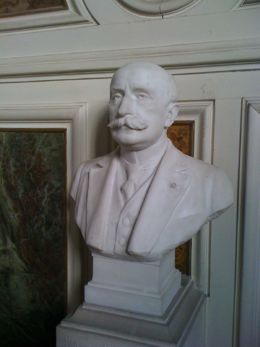Pierre Termier: ATLANTIS - Smithsonian Report 1915 (Summary)
by W.H. Wilcockson
In this publication, which is a translation of a lecture given before the Institut Oceanographique of Paris on November 30, 1912, the author puts forward the evidence in favour of accepting the Platonian account of the destruction of Atlantis as materially true. After giving a general account of the old legend, with quotations from Plato's Timaeus, the author reviews the geological and zoological evidence for the former existence and recent disappearance of the Atlantic Continent. He argues that land must have existed along the lines of the Alpine and Hercynian folds, and also further south along the northern border of the old Gondwanaland, and that this land must have gradually foundered, the old E.-W. lines giving place to the present N.—S. line, as shown by the bank which runs from north to south down the centre of the Atlantic Ocean.
This bank, and the similar banks off the coast of Africa, are connected with volcanic and seismological phenomena as shown by the volcanic islands which are situated on them ; and the deeps on either side of it bear the same relation to the volcanoes as do the deeps off the western coast of America to the Cordillera of the Andes. The presence of undisturbed Miocene beds in the Azores and Canaries shows that land existed in the neighbourhood of these islands in Miocene times, but the writer regards as the chief point in favour of recent submergence the fact that a cable ship in 1898 dredged up some fragments of tachylyte from the sea bottom about 500 miles north of the Azores. This, he says, must have solidified on the surface of the land, as it would have solidified at least into a cryptocrystalline condition at the depth of 3,000 m. where it was found. This fact, coupled with the great inequality and rocky character of the ocean floor at this spot, where the ooze only lies in the hollows, shows that the submergence must not only have been recent but also sudden, as there had been no time for the inequalities of the surface to be eroded.
Turning to the zoological evidence, the author quotes work by M. Louis Germain to show, firstly, that the terrestrial fauna of the Azores, Madeira, the Canaries, and Cape Verde Islands is of continental origin, and shows evidences of adaptation to desert conditions. Secondly, that the Quaternary formations of the Canaries and Mauretania contain the same species of Helix. Thirdly, that the mollusca of the four archipelagoes have affinities with the Tertiary mollusca of Europe ; and, fourthly, that the Oleacinidse group of pulmonate mollusca is confined to the Mediterranean basin, the Azores, Canaries, Madeira, the West Indies, and Central America. All this evidence seems to demand the existence of a continent connecting Europe and Central America which gradually disappeared, beginning with the westerly portions and leaving the easterly portions till the last, and the author considers that it is quite conceivable, if we take into account the unstable condition of the Atlantic volcanic areas, that the final disappearance may have been witnessed by man, and have been so sudden as to constitute a "cataclysm".
Sources
Text:
- Cambridge Journals (Cambridge University Press), "Atlantis. By Pierre Termier. Smithsonian Report for 1915, pp ..." (PDF-file)
Illustration:
